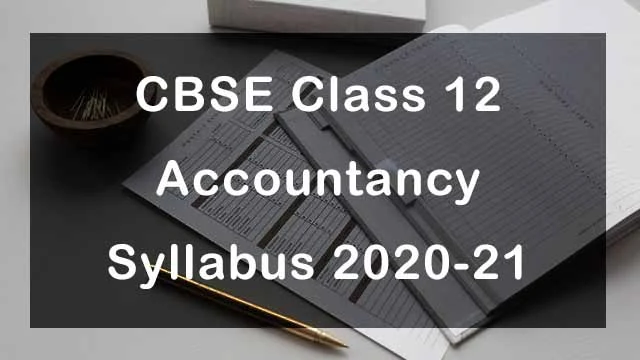CBSE Class 12 Accountancy Syllabus 2020-21| Check Latest Exam Pattern
CBSE has released Class 12 Accountancy Syllabus 2020-21. The syllabus has been revised due to coronavirus pandemic to ease the pressure on students. The question paper will be of 80 marks. Project Work will be conducted of 20 marks.


| Units | Marks | |
| Part A | Accounting for Partnership Firms and Companies | 60 |
| Part B | Financial Statement Analysis | 20 |
| Theory Paper (Total) | 80 | |
| Part C | Project Work | 20 |
OR
| Units | Marks | |
| Part A | Accounting for Partnership Firms and Companies | 60 |
| Part B | Computerized Accounting | 20 |
| Theory Paper (Total) | 80 | |
| Part C | Practical Work | 20 |
Part A: Accounting for Not-for-Profit Organizations, Partnership Firms and Companies
Unit 1: Financial Statements of Not-for-Profit Organizations
• Not-for-profit organizations: concept.
• Receipts and Payments Account: features and preparation.
• Income and Expenditure Account: features, preparation of income and expenditure account and balance sheet from the given receipts and payments account with additional information.
Unit 2: Accounting for Partnership Firms
• Partnership: features, Partnership Deed.
• Provisions of the Indian Partnership Act 1932 in the absence of partnership deed.
• Fixed v/s fluctuating capital accounts. Preparation of Profit and Loss Appropriation account- division of profit among partners, guarantee of profits.
• Past adjustments (relating to interest on capital, interest on drawing, salary and profit sharing ratio).
• Goodwill: nature, factors affecting and methods of valuation - average profit, super profit and capitalization.
Accounting for Partnership firms - Reconstitution and Dissolution.
• Change in the Profit Sharing Ratio among the existing partners - sacrificing ratio, gaining ratio, accounting for revaluation of assets and reassessment of liabilities and treatment of reserves and accumulated profits. Preparation of revaluation account and balance sheet.
• Admission of a partner - effect of admission of a partner on change in the profit sharing ratio, treatment of goodwill (as per AS 26), treatment for revaluation of assets and reassessment of liabilities, treatment of reserves and accumulated profits
• Retirement and death of a partner: effect of retirement / death of a partner on change in profit sharing ratio, treatment of goodwill (as per AS 26), treatment for revaluation of assets and reassessment of liabilities, adjustment of accumulated profits and reserves and preparation of balance sheet.
• Calculation of deceased partner’s share of profit till the date of death.
• Dissolution of a partnership firm: meaning of dissolution of partnership and partnership firm, types of dissolution of a firm. Settlement of accounts - preparation of realization account, and other related accounts: capital accounts of partners and cash/bank a/c (excluding memorandum balance sheet, piecemeal distribution, sale to a company and insolvency of partner(s)).
Unit - 3 Accounting for Companies
Accounting for Share Capital
• Share and share capital: nature and types.
• Accounting for share capital: issue and allotment of equity and preferences shares. Public subscription of shares - over subscription and under subscription of shares; issue at par and at premium, calls in advance and arrears (excluding interest), issue of shares for consideration other than cash.
• Concept of Private Placement and Employee Stock Option Plan (ESOP).
• Accounting treatment of forfeiture and reissue of shares.
• Disclosure of share capital in the Balance Sheet of a company.
Accounting for Debentures
• Debentures: Issue of debentures at par, at a premium and at a discount. Issue of debentures for consideration other than cash; Issue of debentures with terms of redemption; debentures as collateral security concept, interest on debentures. Writing off discount / loss on issue of debentures.
Part B: Financial Statement Analysis
Unit 4: Analysis of Financial Statements
• Financial statements of a Company: Statement of Profit and Loss and Balance Sheet in prescribed form with major headings and sub headings (as per Schedule III to the Companies Act, 2013)
Note: Exceptional items, extraordinary items and profit (loss) from discontinued operations are excluded.
• Financial Statement Analysis: Objectives, importance and limitations.
• Tools for Financial Statement Analysis: Comparative statements, common size statements, cash flow analysis, ratio analysis.
• Accounting Ratios: Meaning, Objectives, classification and computation.
• Liquidity Ratios: Current ratio and Quick ratio.
• Solvency Ratios: Debt to Equity Ratio, Total Asset to Debt Ratio, Proprietary Ratio and Interest Coverage Ratio.
• Activity Ratios: Inventory Turnover Ratio, Trade Receivables Turnover Ratio, Trade Payables Turnover Ratio and Working Capital Turnover Ratio.
• Profitability Ratios: Gross Profit Ratio, Operating Ratio, Operating Profit Ratio, Net Profit Ratio and Return on Investment.
Unit 5: Cash Flow Statement
• Meaning, objectives and preparation (as per AS 3 (Revised) (Indirect Method only)
OR
Part B: Computerised Accounting
Unit 3: Computerised Accounting
Overview of Computerised Accounting System
• Introduction: Application in Accounting.
• Features of Computerised Accounting System.
• Structure of CAS.
• Software Packages: Generic; Specific; Tailored.
Accounting Application of Electronic Spreadsheet.
• Concept of electronic spreadsheet.
• Features offered by electronic spreadsheet.
• Application in generating accounting information - bank reconciliation statement; asset accounting; loan repayment of loan schedule, ratio analysis
• Data representation- graphs, charts and diagrams.
Using Computerized Accounting System.
• Steps in installation of CAS, codification and Hierarchy of account heads, creation of accounts.
• Data: Entry, validation and verification.
• Adjusting entries, preparation of balance sheet, profit and loss account with closing entries and opening entries.
• Need and security features of the system.
Database Management System (DBMS)
• Concept and Features of DBMS.
• DBMS in Business Application.
• Generating Accounting Information - Payroll
Prescribed Books:
• Financial Accounting-I, Class-XII, Published by NCERT
• Financial Accounting-II, Class-XII, Published by NCERT
Download Class 12 Accountancy Syllabus 2020-21

